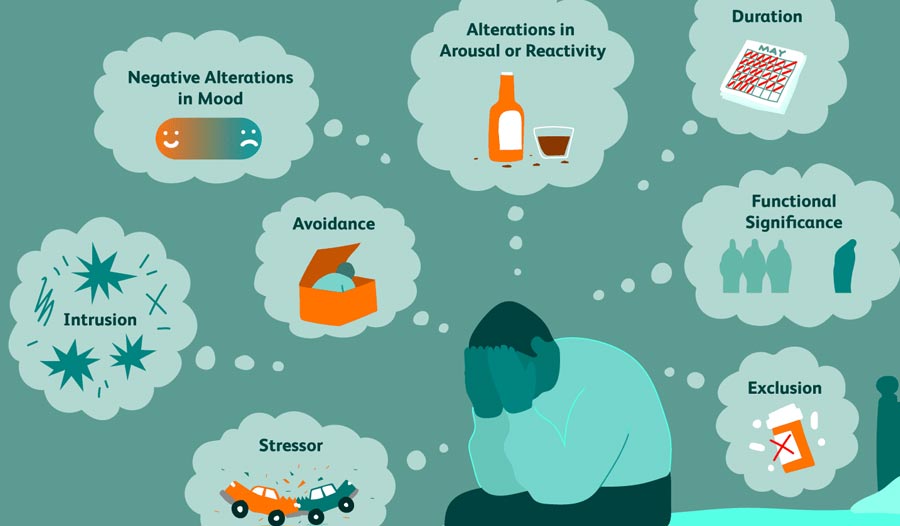PTSD is a mental health condition that develops in a person who has been exposed to a traumatic event, such as a natural disaster, serious accident, assault, witnessing or being the victim of a terrorist event where there was a real or perceived threat to life.
To understand what happens during trauma, imagine the brain like a computer. Usually, it's a great processor and storage for memories, but when something life-threatening or extremely scary or unusually distressful happens, the system becomes overloaded. In PTSD the brain's "software" gets stuck, and memory of the same terrible event or events keeps on replaying over and over again, causing distress.
People suffering from PTSD often experience symptoms like intrusive memories, flashbacks, and avoidance behavior like avoiding the places where the event happened or avoiding talking about the traumatic event. It is accompanied by changes in mood and emotions, feeling of being on the etc.
PTSD may occur at any age. Sometimes, the symptoms start months or even several years after the event. It is important to understand that not all people who have experienced a traumatizing situation will experience PTSD. The nature of the trauma, the perceived threat level, the individual’s resilience, and support systems often determine one's likelihood of potentially developing this disorder.
Living with PTSD can be challenging but with the right kind of psychiatric and psychological treatment, symptoms can be managed. Both therapy and medication are used to address the symptoms and individual distress. CBT (Cognitive Behaviour Therapy) helps improve negative thought patterns, while other therapies like eye movement desensitisation and reprocessing (EMDR ) give excellent ways to process such memories that are no longer so overwhelming. Medication might be helpful for symptoms of comorbid conditions, like anxiety or depression. We at Anvaya have a team of the best mental health professionals to provide support for PTSD.
Support from family and friends is crucial and helps in significant ways. A healthy lifestyle and teaching other coping methods make a difference. Proper response to treatment helps people who have PTSD work through their traumatic experiences and go on to live productive lives.
Complex Post-Traumatic Stress Disorder (CPTSD)
C-PTSD refers to a complex post-traumatic stress disorder where an individual has gone through a series of chronic traumatic incidents. While typical PTSD can even result from a single traumatic event, C-PTSD tends to develop from continuous abuse, neglect, or other stressors such as prolonged domestic violence or childhood abuse.
General C-PTSD symptoms include:
Emotional dysregulation: Individuals diagnosed with C-PTSD often express their emotions intensely and with great unpredictability. They could feel irritated, angry, or anxious and have difficulty managing emotions.
Negative Self-perception: they tend to question their worth and feel inferior to others. This can bring guilt, shame, and low self-esteem.
Relationship issues: people suffering from C-PTSD might have difficulty trusting people which leads to unhealthy formation and maintenance of healthy relationships. They might feel detached from the people or overly dependent on them.
Experienced Flashbacks and Nightmares: Much like PTSD, C-PTSD is also accompanied by memories or flashbacks of traumatic events, thus questioning one's belief that they are safe.
Avoidance: People having C-PTSD avoid as much as possible any reminder of their trauma, which would further restrain their interaction with others and social engagement.
Hypervigilance: Persistent state of alertness. People with C-PTSD can sometimes feel grounded even though they are not in any direct danger, constantly scanning.
Dissociation: they often feel disconnected from the world and feel like they are not connected with one’s own body.
C-PTSD is like PTSD but with added layers—in both cases—due to either the repeated nature of the trauma or its long-lasting effect. It does go beyond just managing the memories of traumatic events, however. It also involves living through a traumatic experience with oneself, as a changed individual, and with others.
Therapists use unique approaches, such as EMDR (Eye Movement Desensitization and Reprocessing) or CBT (Cognitive Behavioral Therapy), to process and make sense of the traumatic experiences. Therapy can teach skills to deal with acute emotions and decrease symptoms like flashbacks or hypervigilance. Therapists work on changing negative self-beliefs to form a positive self-image and help improve relationships and communication with others. Therapy provides a safe environment to discuss and work through what happened.



